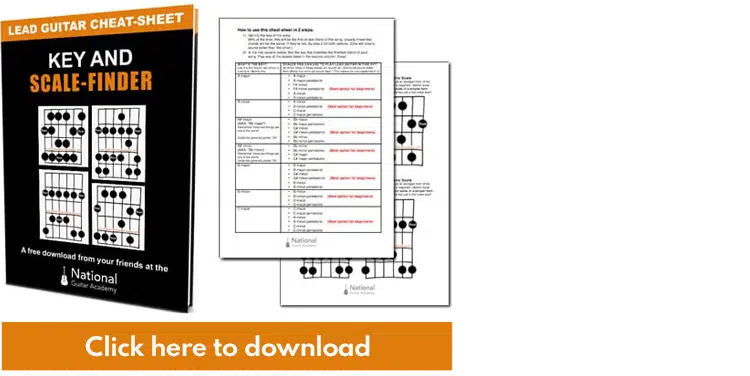Bass guitar scales that shake the earth! Here’s our 5 favourite ‘must-know’ bass guitar scales.
In this free guide you will learn:
- 2 quick and easy tips to learn bass scales at lightning speed.
- 5 essential bass guitar scales that will make you sound incredible.
- The #1 top-secret tip that will help you learn scales in ALL keys.
Over 100,000 guitar-learners get our world-class guitar tips & tutorials sent straight to their inbox:
Click here to join them
Get our best guitar tips & videos
Bass guitarists are champions of the rumble, and for good reason!
An often unsung hero, the bass player is the backbone of any band.
- The low-end thump of a bass guitar exists in almost every memorable song that you’ve ever heard on the radio.
- You may not always hear it, but you’ll definitely feel it.
- Underpinning every great bassist is a series of bass guitar scales and patterns that make up the musical lines they play.
Whether you’re just starting out or you’ve already got some wear on your fretboard, we’ve got a great lesson in store for you.
Before we begin, let’s clear up a few words and concepts to avoid confusion:
The scale patterns you are about to learn can be played anywhere on the fretboard, but all examples will be shown in the key of C.
The bass guitar scale patterns that we discuss are the exact same scale patterns that you will see on a guitar.
The only difference is how the scales are formatted, due to the bass only having four strings (or five, if you’re fancy)
It is important to note that the patterns themselves will never change, the only thing that changes is WHERE you begin to play the pattern. The pattern itself is movable.
- Start them on the 5th fret of the 6th string and you’ll be playing an A scale of some kind.
- Start them on the 7th fret of the 6th string and you’ll be playing a B scale of some kind.
- Start them on the 8th fret of the 6th string and you’ll be playing a C scale of some kind.
And so on…
We will primarily be referring to two different scale types – ‘Diatonic’ and ‘Pentatonic’
- Diatonic = A scale with seven notes
- Pentatonic = A scale with five notes
Any of these scales can be played over any genre of music, but we’ve included some suggestions to start you on the right path.
These are by no means the only genres to play these scales in, and you should feel free in your creativity to experiment to your heart’s content!
Okay, now that’s out of the way – Let’s get to some bass guitar scales!!
The Major Diatonic Bass Guitar Scale (aka the Major Scale)
Composed of seven notes, the major diatonic scale carries a positive and uplifting vibe.
As amazing as it is for writing sappy ballads about your first love, it’s also an incredibly powerful scale to use in genres like soul and funk.
- The slower you play the major scale, the sweeter it sounds.
- Pick up speed however, and things can get groovy really fast.
- In order to play this scale, we’ll need to use all four fingers.
For this example (C Major), let’s position our hand on the fretboard like so:
7th: Index
8th: Middle
9th: Ring
10th: Pinky
Our root note of the scale begins on the 8th fret, but we move to the 7th fret when we reach the A string.
When we begin this bass guitar scale with our middle finger, we set ourselves up to not have to shift hand positions.
This technique makes learning bass guitar scales a much easier process, and helps avoid the feeling of “jumping around” the fretboard.
Skill Tip: If you’ve ever seen the movie/play “The Sound of Music,” you should remember this scene here. If you haven’t, set some time aside for it – it’s a great film!
- In this scene, Fraulein Maria (the main character) sings the names and notes in the Major Diatonic scale (Do – Re – Mi – Fa – Sol – La – Ti – Do) and gives her children a beautiful little song to remember it by.
- Each name listed above represents one note (or ‘degree’) of the major diatonic scale.
Have a look below to learn about the seven degrees of the major scale and how to play it as a bass guitar scale:
DO (I) RE (II) MI (III) FA (IV) SOL (V) LA (VI) TI (VII) DO (I)
Let’s try playing along to Queen’s ‘Under Pressure’
Another great song that uses the major diatonic scale is Bill Withers’ ‘Lovely Day’ (E Major)
Click Here to jam this scale over a backing track! (C Major Diatonic Scale – 8th fret)
Download our lead guitar cheat-sheet to make things easier
It's hard to understand which scales work with which keys.
So we created a cheat-sheet! A key and scale-finder that you can use again and again.

Get your personalised guitar-learning plan 🎸
Get a custom guitar-learning plan here: Click here for GuitarMetrics™
World-Class Guitar Courses 🌎
Learn from the world's best guitar educators: Click here for our guitar courses
The Major Pentatonic Bass Guitar Scale
The younger sibling to the major scale, the major pentatonic scale has only five notes.
Because of its simplicity, this bass guitar scale is excellent for playing straight-ahead rock and roll music as well as blues.
In order to understand this bass guitar scale better, we need to look at the difference in notes between the major diatonic scale and the major pentatonic scale:
- DIATONIC: DO (I) RE (II) MI (III) FA (IV) SOL (V) LA (VI) TI (VII) DO (I)
- PENTATONIC: DO (I) MI (III) FA (IV) SOL (V) TI (VII) DO (I)
In the major pentatonic scale, we remove Re ( II ) and La (VI).
This leaves us with a more ‘open’ sounding scale than the one we looked at above.
Skill Tip: If you’re positioning your hand properly, you shouldn’t need to use your ring finger at all for this scale!!
Remember to make use of your pinky finger for those long stretches!
Let’s try something cool.
Below, we have what we call a “walking bassline”
- Take your time and work through this one slowly.
- The goal with this exercise is to play the notes as evenly as you can.
This little bass guitar scale run is a fantastic way to develop a sense of groove and timing. Spend some time with it!
Another great song that uses the major pentatonic scale is Stevie Wonder’s ‘Sir Duke’ (B Major)
Click Here to jam this scale over a backing track! (C Major Pentatonic Scale – 8th fret)
Note: This jam track is the same as the one above it – Try playing a C major pentatonic scale over this progression, then switch to a diatonic scale to hear the differences in action!
The Minor Diatonic Scale (aka the Minor Scale)
The moody cousin of the major family, this bass guitar scale carries a darker attitude with it.
- Heavily used in rock and metal music, this scale is great to add a sense of darkness to your next melody.
- The minor scale’s dark character comes from its use of a different arrangement of notes than its cousins above.
Check out the TAB below to see the difference, then try playing the major and minor scales back-to-back to hear it.
Skill Tip: Unlike the major bass guitar scales, you will need to start with your index finger on the root note this time.
See below for the proper hand position:
8th: Index
9th: Middle
10th: Ring
11th: Pinky
A fantastic song that makes use of this bass guitar scale is ‘Feel Good Inc.’ by Gorillaz‘
Have a look at the TAB below to play along:
Another great song that uses the minor scale is Nirvana’s ‘Smells Like Teen Spirit’
Click Here to jam this scale over a backing track! (C minor Diatonic Scale – 8th fret)
The Minor Pentatonic Bass Guitar Scale
Pentatonic scales of either the major or minor variety sound great over many blues and funk songs.
The minor pentatonic scale however, is a weapon of choice for many bass guitarists due to its versatile and ‘open’ sound.
This scale also removes two notes from its diatonic cousin in order to create a less moody (and more direct) sound.
Featured in Bruno Mars and Mark Ronson’s ‘Uptown Funk,’ this bass guitar scale is perfect for the bassist looking to lay down the groove.
It also works exceptionally well in the world of rock and roll!
Skill Tip: The minor pentatonic scale has a very consistent pattern to it, and you won’t need your middle finger at all to play it!
Practicing movement between your index and ring fingers, as well as your index and pinky can help us build speed and proficiency a lot faster.
Now let’s get down to some Uptown Funk:
Another great song that uses the minor pentatonic scale is Pink Floyd’s ‘Money’ – Have a listen!
Click Here to jam this scale over a backing track!





















